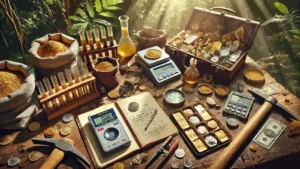Gold is one of the most valuable metals and is used in many electronic devices for its excellent conductive properties and resistance to corrosion. Recovering it from electronic waste not only reduces waste and earns a little money, but also provides an educational opportunity for those who want to recycle precious metals.
In this guide, we will explore the process of extracting pure gold from circuit boards, describing the steps involved, the tools needed, and the chemicals involved. Carefully following the instructions is essential to ensure safe and effective recovery.
Potentially dangerous procedures:
This content is provided for demonstration purposes only. The author disclaims any liability for any damage, incident or misuse of the information provided.
Contents
#1. Gold-rich electronics 📟
Many electronic devices contain significant amounts of gold, used primarily for its highly conductive electrical contacts. Recovering this precious metal can be a profitable operation, especially if you accumulate enough electronic components to process. As a guide, from 100 CPUs of old computers you can extract about 1-2 grams of gold , while from 200-300 RAM cards you can obtain about 1 gram of gold. The devices richest in gold include:
- Motherboards and Printed Circuit Boards,
- Gold-plated connectors, found in cables and network devices,
- Processors and CPUs, containing gold-plated micro contacts,
- RAM memories, with gold contacts visible along the edge,
- Older video and sound cards, containing gold-plated connectors,
- Cell phones, especially older ones,
- Relays and electrical contacts, used in industrial equipment.
#2. Tools and materials needed 🛒
To successfully mine gold, you need to get specific equipment and the right chemicals. The ratios vary depending on the amount of gold to be mined. Here are the recommended amounts for 1 gram of expected gold:
- Rubber gloves and safety glasses, to avoid contact with acids,
- Pliers and screwdrivers, for disassembling electronic devices,
- Nitric acid (HNO3) (100 ml), also known as “azotic acid”, for dissolving metals,
- Hydrochloric acid (HCl) (300 ml), also called “muriatic acid”, used to create aqua regia,
- Urea (15 g), used to neutralize residual acid,
- Sodium metabisulfite (5 g), a precipitant for recovering dissolved gold,
- Glass flasks and stirring rods, for mixing the solutions,
- Paper filters, to separate metals from impurities,
- Graphite mold, a strong container for melting gold,
- Oxyacetylene torch or oxyhydrogen flame, to reach the melting temperature of gold (1064°C).
#3. Safety precautions 🚨
Since corrosive and toxic chemicals are used, it is essential to take proper safety measures. The following precautions will reduce the risk of accidents during the process:
- Work in a well-ventilated area or outdoors, to avoid the buildup of toxic fumes,
- Always wear gloves, safety glasses and a chemical mask, to protect yourself from splashes and harmful fumes,
- Do not mix chemicals without proper knowledge of the reactions, as some combinations can be dangerous,
- Dispose of chemical waste responsibly, in accordance with current environmental regulations,
- Always keep running water and a fire extinguisher handy in case of emergency.
#4. Extraction procedure 🧪
Removing gold components
Once you have collected the electronics, the first step is to physically separate the gold components from the rest of the circuit boards. This can be done with:
- Pliers and screwdrivers, to remove gold-plated connectors and contacts,
- Fine sandpaper or a file, to remove any protective coatings,
- A bath in weak acid (vinegar and salt) to facilitate the removal of gold plating.
Dissolving gold with acids
After you have dissolved the gold, you need to precipitate it and purify it. Follow these steps:
- Add 15 g of urea to neutralize the excess acid,
- Pour 5 g of sodium metabisulfite into the solution, stirring slowly,
- Wait for the gold to precipitate as a brown powder,
- Filter the gold dust and rinse it with distilled water.
Recovering and purifying gold
Dopo aver sciolto l’oro, è necessario farlo precipitare e purificarlo. Segui questi passaggi:
- Aggiungi 15 g di urea per neutralizzare l’acido in eccesso,
- Versa 5 g di metabisolfito di sodio nella soluzione, mescolando lentamente,
- Attendi che l’oro precipiti sotto forma di polvere marrone,
- Filtra la polvere d’oro e risciacquala con acqua distillata.
Smelting and refining
The last step is to melt the gold to obtain a pure ingot. Here’s how to proceed:
- Collect the gold dust and place it in a graphite mold,
- Use an oxyacetylene torch or blowtorch to heat the gold to its melting temperature (1064°C),
- Wait until the metal becomes completely liquid , then pour it into another mold if necessary,
- Allow the ingot to cool before handling.











Leave a Reply